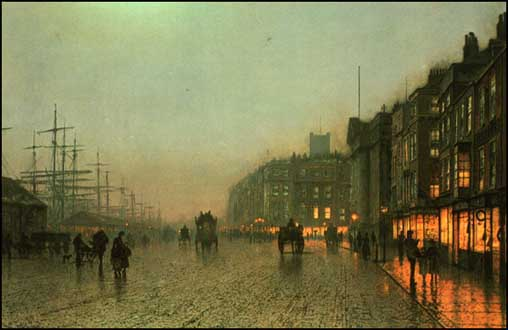“Leeds painter of landscapes, town views and dockyards, especially at sunset or by
moonlight. Born the son of an ex-policeman, Grimshaw first began painting while working
as a clerk for the Great Northern Railway. He encountered bitter opposition from
his parents, but after his marriage in 1858 to Theodosia Hubbarde, a cousin of T.S.
Cooper, he was able to devote himself to painting. Grimshaw painted mostly for private
patrons, and exhibited only five works at the Royal Academy between 1874 and 1886,
and one at the Grosvenor Gallery. The towns and docks that he painted most frequently
were Glasgow, Liverpool, Leeds, Scarborough, Whitby and London. Grimshaw’s style
and subject matter changed little during his career; he strove to constantly perfect
his own very individual vision. He was interested in photography, and sometimes used
a camera obscura to project outlines on to canvas, enabling him to repeat compositions
several times. He also mixed sand and other ingredients with his paint to get the
effects he wanted. Although he established no school, Grimshaw’s pictures were forged
and imitated in his lifetime, notably by Wilfred Jenkins and H. Meegan. Although
his moonlit town views are his most popular works, he also painted landscapes, portraits,
interiors, fairy pictures and neo-classical subjects. During his early period he
signed “J.A. Grimshaw” but c.1867 dropped the John, and signed himself Atkinson Grimshaw.
He usually signed his pictures on the front and the reverse, inscribed with the title.
Two of his sons, Arthur and Louis, were also painters.”
(Biographical source: Wood, Christopher. The Dictionary of Victorian Painters.)



